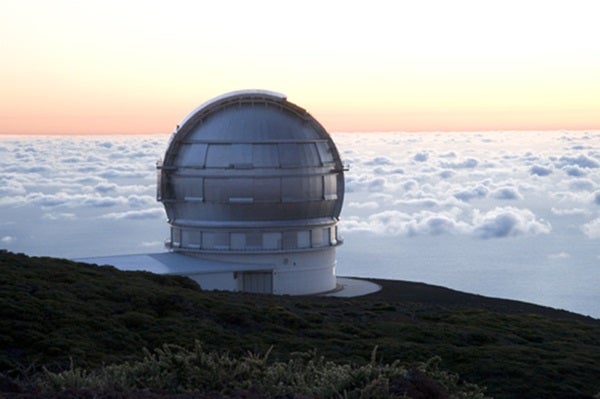Four hundred years after Galileo first turned his handmade telescope toward the heavens, the world’s largest telescope is set to make its formal debut.
The inauguration of the Gran Telescopio Canarias (GTC) is scheduled for July 24 in Spain’s Canary Islands. The telescope’s 10.4-meter diameter mirror boasts more light-collecting area than any other instrument of its kind. Officials and astronomers from the University of Florida, the only U.S. institution that is part of the project, will join more than 500 astronomers, journalists, and celebrities in a ceremony presided over by Spain’s King Juan Carlos I and Queen Sofia.
“The completion and inauguration of the GTC is a huge milestone for astronomy and for the University of Florida (UF) in collaboration with its partners in Spain and Mexico,” said Joe Glover, University of Florida provost. “We look forward to our astronomers playing a central role in the major discoveries this uniquely powerful telescope will enable.”
Perched 7,874 feet (2,400 meters) above sea level atop a mountain on the island of La Palma, the GTC has 65 square feet (6 square meters) more light-collecting area than any of the roughly one dozen 8- to 10-meter telescopes worldwide. With a mirror composed of 36 hexagonal segments thought to have the smoothest surfaces ever made, it’s also the world’s most technologically advanced optical telescope. Sensors keep the mirrors aligned to counteract the force of gravity, so they act as a single surface, even as the telescope is rotated and aligned in place.
Astronomers designed and built one of the first two astronomical instruments for the telescope, a multimillion-dollar heat-sensing camera called CanariCam.
Stan Dermott, chairman of UF’s astronomy department, said the GTC’s size and technical attributes enable it not only to gather more light than any other telescope, but also resolve the light into sharper and clearer focus. For astronomers, he said, those capabilities make it a powerful tool to study cosmic origins — the early days of the universe and the very early moments in the mysterious births of stars, planets, and galaxies.
“The interpretation of the structure of the disks where new planets form is highly dependent on the quality of the image,” Stan said, adding that the GTC also will enable the discoveries of new planets, possibly including the first habitable planet.
The telescope gathers the light, but only astronomical instruments can reveal the mysteries it contains. The car engine-sized CanariCam, built at UF but now in La Palma and expected to become operational next year, “sees” the infrared light — the invisible light that accompanies heat — emitted by stars and planets as they form in space. It also sees the light that, in its visible form, is obscured by the dust clouds and gas in space.
CanariCam is unique among mid-infrared cameras in its ability to determine the direction of polarized light and accomplish coronagraphy, which blocks the bright light of stars to make faint, nearby planets more visible. Those abilities will help it reveal cool planets and more about the role of magnetic fields in planet and star formation, said Charles Telesco, UF astronomy professor and the principal investigator on the CanariCam project.










